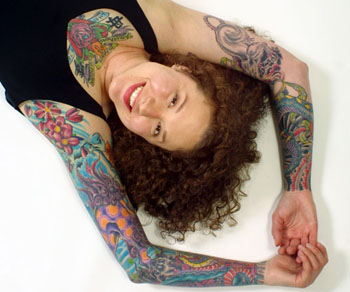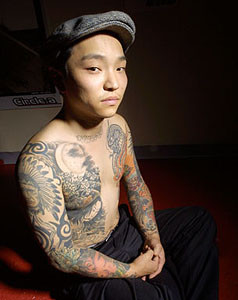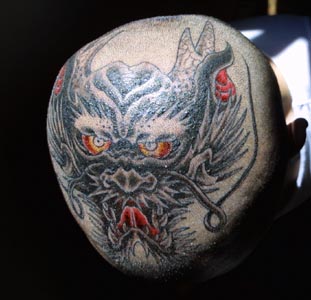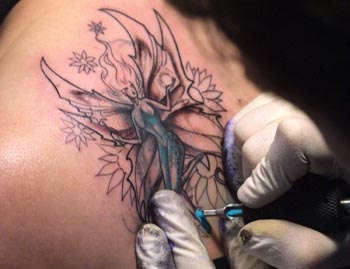![[Metroactive Features]](/features/gifs/feat468.gif)
[ Features Index | San Jose | Metroactive Central | Archives ]
 Photograph by George Sakkestad Skin Deep: Michelle Kraver says her tattoos are for her own enjoyment, not for the effect they have on others Needle Freaks Once thought of as a passing trend, body tattoos remain more popular than ever. And a big part of the customer base is repeat customers. Is body art like any other addiction, where more has just got to be better? By Kelly Luker MY FIRST TATTOO WAS ALMOST 30 years ago, chosen and inked in a haze of mind-numbing and--thank God--body-numbing chemicals. There was no purpose, no meaning to it except the age-old raison d'être: It seemed like a good idea at the time. The second one followed a year later, under remarkably similar circumstances. My next tattoo joined the other two in November of last year and this time almost everything was different. I gritted my teeth, bared my skin and bore the pain without anesthetic. Etched on the anniversary of my mother's death, this one had more meaning, more soul. But one thing remained the same: before the last smear of blood was wiped away, I was already wondering what kind of tattoo I was going to get next. I don't know why, but when it comes to tattooing my own body, it just seems like more is better. And I'm not alone in this. Following the yuppie-populated paths of Harley-Davidsons, pierced ears and leather jackets, tattoos have found a comfy home in middle-class America, an America that longs for a whiff of bad-to-the-bone counterculture but is unwilling to commit to prison time or rock stardom to earn it. From its back-alley doorways and Tenderloin digs, tattoo parlors have bellied up to the high-rent trough, transforming themselves into "tattoo art studios" and becoming the sixth biggest retail business in the country. Judges, counselors, accountants, athletes and soccer moms are lining up outside the parlor doors for their own permanent body décor. And almost half of them return for more. Myrna L. Armstrong, a professor at Texas Technical University School of Nursing, has been studying the psychology and social patterns behind the tattoo fetish for the last dozen years. Regardless of the demographics--college students, teenagers, military or career women--Armstrong found that about 40 percent of those surveyed had two or more tattoos. That last group--middle-class, post-college-age women--is the fastest-growing segment of a tattooist's clientele, according to surveys published in medical journals, universities and media found on the web. Unscientifically, I'd have to agree. My 39-year-old friend Kimberly has her kids' names on her ankle, an elephant over her heart and the date of her sobriety permanently printed on the base of her spine. A 40-something co-worker has a rose on her upper arm and a heart over her heart. Then there's the more extreme case of 31-year-old Michelle Craver, who's inching ever closer to a "body suit"--interlocking ink designs that will eventually camouflage most of her body, from neck to ankles. And no, she is not worried about how she will look on her wedding day. These people are not rebels. They are not masochists. They have just found something utterly compelling in the process and outcome of needles injecting tiny droplets of ink into images and patterns on the skin. In any case, what once seemed like a passing trend isn't going away. It's enjoying a healthy influx of repeat customers who can't get enough.
Photograph by George Sakkestad
Turning Japanese CRAVER LEANS back in a relaxed pose as we talk, her right arm out and turned up while Miki ("just Miki--no last name") runs a tattoo pen in swift strokes from her wrist to her inner elbow. Craver is a steady client of Miki's at Santa Cruz' True Art Tattoo Studio. Steady, as in once or twice a month. The pretty brunette got her first tattoo back in Seattle when she turned 18. Craver says she knew tattoos were going to be in her future ever since she watched the designs ripple and jump on her grandfather's arm when she was just a little girl. "My brother and I were enthralled with them," she remembers of her first sighting of her grandpa's military tattoos. "And I knew I'd get more tattoos when I got my first one." But she waited before getting the rest. It wasn't until the last year, maybe year and a half, that she got the other dozen or so. Although Craver's multiple tattoos would more likely get her labeled as biker instead of soccer mom, she is neither. A nurse, Craver is director of Health Services for Aegis Assisted Living, a senior housing organization. "Dozen or so" is perhaps a misnomer for her body art, implying several rosebud-sized designs. In fact, most of Craver's work would be better classified as murals. A couple of large Japanese koi circle lazily across her left arm. They are joined by a Foo Dog ("I was born in the Year of the Dog," Craver explains) and a snake uncoiling ("I had this done in the Year of the Snake") throughout the tableau. A scattering of cherry blossoms covers her armpit. "I like Japanese art," says Craver, stating the obvious. Today, a pair of Japanese-influenced rats, as well as a dragon, are in line for extra shading and color work. Craver wears the not-so-Asian influence, too: a pair of fairies perched on her shoulder blades and the initials "F.T.W." inscribed on the back of her neck. "Fuck the War?" I ask, a little confused by the anachronism. "Fuck the World," Craver explains. "I couldn't understand why someone would ever get F.T.W. Then--OK, this sounds stupid--but someone stole my purse at a club one night. It was a horrible night. So Miki was kind enough to come in on his day off and ..." she shrugs. It does sound stupid, until Craver gets to the core of why she chose it. "I guess it means more that I don't care what people think of me," she says. Craver says she keeps getting tattoos because she likes them, and the hell with whatever judgment the rest of the world weighs in with. "I don't think it's addictive, not in the true sense of the word," Craver muses, as Miki burns scarlet into the dragon. "But the more you get, the more you want. As I get new tattoos, I look at my arm and think, That's so beautiful--and that's my arm!"
Hooked on Ink: Psychologists speculate that tattoo addiction is a unique cocktail of pain, artistic freedom, body worship and rebellion. (Photo: tattoo artist and collector Javier Gonzales.) Hurts So Good MAYBE CRAVER wouldn't call it addictive, but a lot of people on both ends of the needle would. "You get hooked on the pain," figures Martin Kenney, who owns the appropriately named San Jose tattoo studio House of Pain. "You get an endorphin rush," he explains. "You almost pass out--that's part of the rush. "I like the pain of it," he says, smiling dreamily. He keeps himself happy apparently, since, like most tattooists, he's covered with ink. "Mentally, it's addictive," agrees Francisco Vales, better known as Paco Excel, co-owner of San Jose's Newskool tattoo studio. He also notes that getting tattooed provides a social component that clients may not recognize. "We're kind of like a bartender," Paco says. "People start to share intimate details with us when they start feeling the pain." As far as Craver's concerned, visiting Miki is like visiting her hairdresser. "I enjoy the whole experience," she laughs. "It's like therapy; I totally look forward to it. I love hanging out here with Miki, the smell of the soap--the whole shebang!" "It's completely addictive for a lot of people," agrees tattoo parlor owner Cheri Lovedog. Cheri might fall into that category, since she's been getting herself tattooed for the last 25 years. "Definitely addictive," adds Beau Lane, a 25-year-old visitor from Mendocino County who was getting a shamrock etched onto his left elbow at Lovedog studios. Lane decided to get this tattoo now because "I had a baby-sitter," he shrugged, and was able to pop in for a quick one. "It hurts and hurts and then it doesn't," explains Lane's tattooist, Zack Gaylord, as he concentrates on Lane's cloverleaf. "Then you get kind of drowsy and relaxed." Addictive. Totally addictive. Oh yeah, addictive. It doesn't seem to matter whether it's the tattooist or the tattoo-ee being asked, the answer is invariably the same, and almost always accompanied by a self-conscious laugh. "Addictive" is one of those often bandied about, rarely understood words, but according to at least one specialist in addiction, there may be a physiological basis to getting hooked on ink. "It's an interesting kind of addiction," says Jan Tice, executive director of Janus, an alcohol and drug program that offers detox and residential treatment. "There's a couple of elements to it. They can love the feel of the tattooing, the line between pleasure and pain. We know in the biochemical process, the endorphins--our own natural heroin--are released as a process of pleasure and pain. "It's euphoric, it's enjoyable and it hurts like hell," Tice continues. Tice is used to dealing with folks looking for something at the end of a needle, and in his opinion, it's usually in the spiritual realm. "I see this with a lot of people who get addicted, is that they have a lot of spirituality and they are looking for a way to connect." Needle Freaks NOWADAYS, though, tattoos are just as likely to be found on teetotalers as on tweakers. But do addicts, particularly those who are off the spike, get a bigger jones for a tattoo fix? Not according to Sarah Hippert, a 21-year-old resident at Janus Perinatal, a treatment program for pregnant women and mothers with substance abuse problems. Already two weeks overdue, Hippert is more than ready to join the latter group. She's been here six months, working on getting over a brutal heroin addiction. Pointing to a cluster of cherries on each side of her chest and a Chinese calligraphy mark meaning "inseparable," Hippert mentions with little emotion, "I got those when my boyfriend died of an OD." There's the tattoo of a nurse on her shoulder, holding a large syringe. "I got that two days before I relapsed," she remembers. In all, there's maybe a dozen, including Hippert's first, a sun tattooed on her stomach when she was 13. She's a little surprised that a dozen would be considered signs of a tattoo collector. "I don't have a lot of tattoos," says Hippert, "I can still count them." She says her mom keeps asking her when she's going to stop getting tattooed. "I tell her, 'When I have one tattoo,'" she smiles. As one who has experienced true addiction, how does Hippert rate the siren call of the next tattoo with her other drugs of choice? "There's an adrenaline rush," Hippert admits, "and I definitely have a needle fetish." Besides her tattoos, the young bottle-blonde also admits to 17 piercings. As we talk, I can only count three that are visible. But Hippert says she doesn't switch to tattoos or piercings when she's clean and sober as an alternate fix. Well, maybe once in awhile. "I was trying to get clean and I had a big check," she explains, pointing to an exploding cherry bomb imprinted behind her right ear. "I did that instead of buying drugs." Asked if she expects to get more in the future, Hippert shakes her head with a small smile. "Not for a while," she says, shifting her extremely pregnant body uncomfortably. "Not for a long while. Babies are expensive, you know."
Inky Dinky Dues: 'It hurts and hurts and then it doesn't,' explains tattooist Zack Gaylord. 'Then you get kind of drowsy and relaxed.' Now and Forever IF, FOR ARGUMENT'S sake, getting tattooed is addictive, it might as well line up with bass fishing, bidding on eBay or a hundred other behaviors that can be stunningly annoying to loved ones and onlookers but relatively harmless to those who practice it. Its biggest problem is that, unlike art people hang over their mantle, tattoos are a permanent reminder of a temporary moment, a loved one, a philosophy, a worldview that is almost sure to change as the years tick by. No one knows how many will end up bitterly regretting that hour or, in people like Craver and Hippert's cases, those many hours under the ink gun. For Paco, his body art is a series of road signs, insignias that remind him of where he has been. "It's inevitable that my taste will change in tattoos," says Paco, "but that's part of the process. I'm always thinking and changing. Whatever you're going through in your life, that's what you get." And unless tattoos swathe the face or hands, or advertise mental midgetry with swastikas or gang insignias, they just don't seem to throw up the social barriers they once did. We ink-stained wretches still hear the line, usually with a sniff: "I can only imagine what you're going to look like when you're 70." The answer, of course, is like everyone else with seven decades of living behind them: saggy and relatively unappealing. Tattoos won't much help or hinder that, one way or another. Craver puts it best when she hears the occasional "tsk, tsk," the offhand, "But you're such a pretty girl!" She agrees there might be a day when her body designs don't look quite as good to her as they do now, but she vows she'll never regret them. "Look," Craver says, studying the needle buzzing across her wrist. "I wish people would understand that my tattoos are not for them to understand and like. "They're for me to understand and like." [ San Jose | Metroactive Central | Archives ]
|
From the July 26-August 1, 2001 issue of Metro, Silicon Valley's Weekly Newspaper.
Copyright © 2001 Metro Publishing Inc. Metroactive is affiliated with the Boulevards Network.
For more information about the San Jose/Silicon Valley area, visit sanjose.com.
 Point Well Taken: The multiple-tattooed, like Horishow, a visiting tattoo artist from Japan, say that their tattoos remind them of past experiences and represent a record of their lives and artistic tastes.
Point Well Taken: The multiple-tattooed, like Horishow, a visiting tattoo artist from Japan, say that their tattoos remind them of past experiences and represent a record of their lives and artistic tastes.

